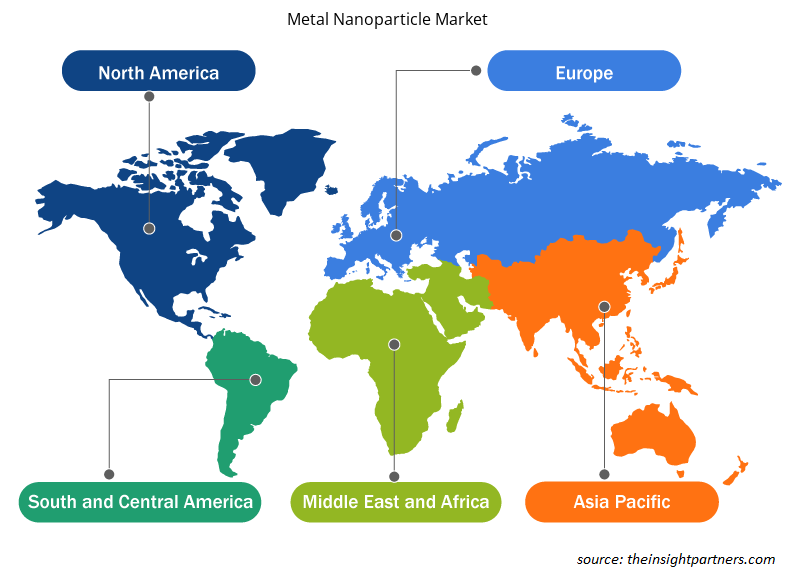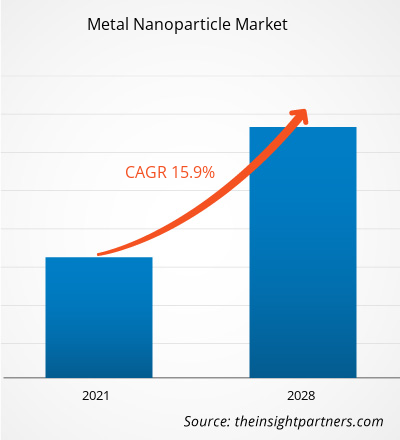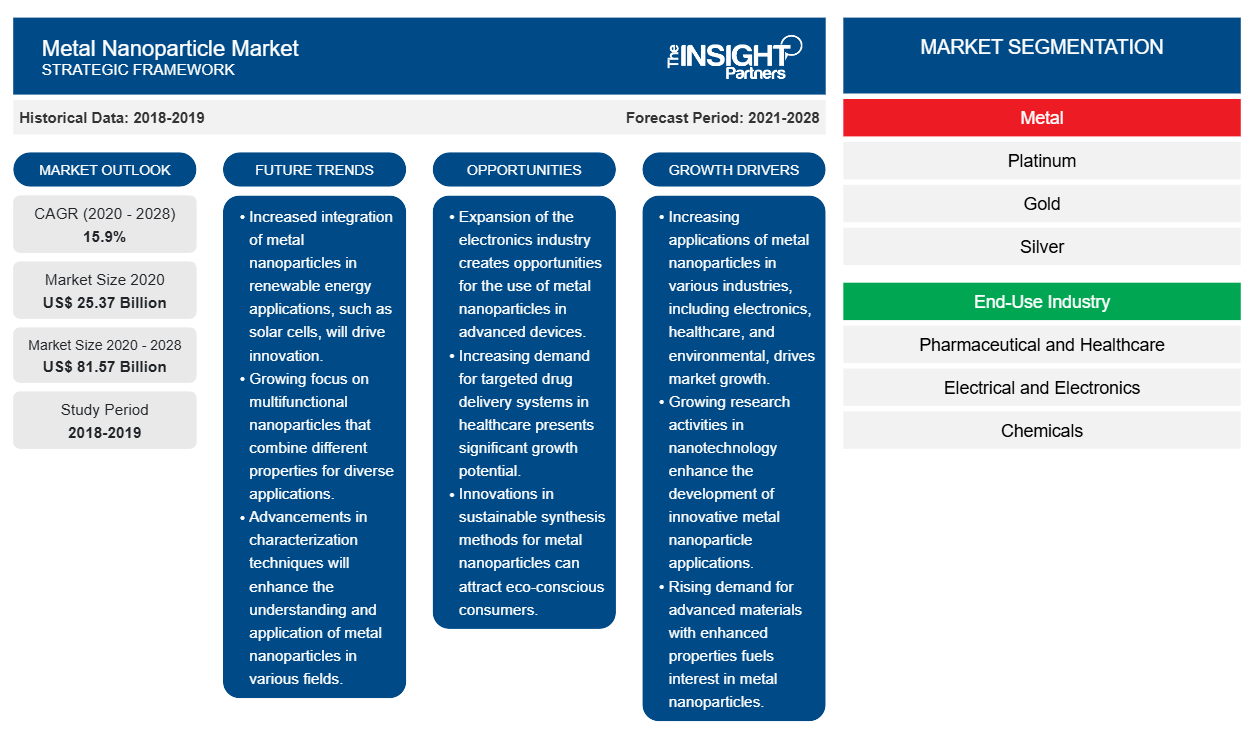[Forschungsbericht] Der Markt für Metallnanopartikel wurde im Jahr 2020 auf 25.373,92 Millionen US-Dollar geschätzt und soll bis 2028 81.567,38 Millionen US-Dollar erreichen; von 2021 bis 2028 wird ein durchschnittliches jährliches Wachstum von 15,9 % erwartet.
Metallnanopartikel haben außergewöhnliche Eigenschaften wie ein hohes Aspektverhältnis und eine einheitliche Größe. Sie werden in einem breiten Anwendungsspektrum eingesetzt, beispielsweise in der Katalyse, in der Medizin und bei der Energiespeicherung. Die Metallnanopartikel haben verschiedene Anwendungen in Endverbrauchsbranchen, beispielsweise in der Pharma- und Gesundheitsbranche, in der Chemie, der Kosmetik sowie in der Elektro- und Elektronikbranche.
Im Jahr 2020 hatte Nordamerika den größten Marktanteil. Die zunehmende Entwicklung des Pharma- und Gesundheitssektors und die steigende Nachfrage nach nachhaltigen Energieressourcen haben die Nachfrage nach Metallnanopartikeln in Nordamerika erhöht. Dank der Präsenz von Industrieländern wie den USA und Kanada und der förderlichen staatlichen Unterstützung von F&E-Aktivitäten erforschen und produzieren die Länder der Region innovative Produkte. Darüber hinaus haben die Fortschritte in der Medizintechnik und die erhöhten Investitionen in den Gesundheitssektor die Nachfrage nach Metallnanopartikeln in der Medizinbranche angekurbelt. Darüber hinaus hat die Präsenz inländischer und internationaler Metallnanopartikelunternehmen in der Region lukrative Möglichkeiten für den Metallnanopartikelmarkt in der Region geschaffen.
Die anhaltende COVID-19-Pandemie hat erhebliche Auswirkungen auf den Markt für Metallnanopartikel. Der Ausbruch hat die Betriebseffizienz beeinträchtigt und die Wertschöpfungsketten aufgrund der plötzlichen Schließung nationaler und internationaler Grenzen unterbrochen, was zu Umsatzverlusten und Schäden geführt hat. Die Störungen in der Produktion und Lieferkette haben sich negativ auf den Markt für Metallnanopartikel ausgewirkt. Die Einführung von Ausgangssperren in verschiedenen Ländern zusammen mit Reisebeschränkungen hat die weltweite Produktversorgung verringert und den Logistikbetrieb reduziert. Es wird an der Verwendung von Goldnanopartikeln für COVID-19-Testkits geforscht, die die Ergebnisse innerhalb von Minuten liefern sollen. In den USA behauptete eine Gruppe von Forschern an der University of Maryland, sie hätten einen Diagnosetest entwickelt, der das neuartige Coronavirus, das COVID-19 verursacht, innerhalb von 10 Minuten nachweisen kann und dessen Ergebnisse mit bloßem Auge sichtbar sind. Der Test ist ein einfacher kolorimetrischer Test, der Goldnanopartikel verwendet, die mit der Nukleinsäuresequenz des Nukleokapsidphosphoproteins des SARS-COV-2-Virus beschichtet sind. Darüber hinaus hat Sugentech, Inc. (ein Unternehmen in der Republik Korea) das SGTi-flex COVID-19 IgM/IgG-Testkit entwickelt, ein immunchromatographisches Testkit auf Basis von Goldnanopartikeln, das die IgM- und IgG-Antikörper von COVID-19 bestimmt. Der Test hilft bei der Bestimmung der Antikörper, bei denen es sich um spezifische Proteine handelt, die als Reaktion auf die Infektion entwickelt werden. Daher wirkt sich eine zunehmende Verwendung von Goldnanopartikeln im Gesundheitssektor positiv auf den Markt für Metallnanopartikel aus.
Passen Sie diesen Bericht Ihren Anforderungen an
Sie erhalten kostenlos individuelle Anpassungen an jedem Bericht, einschließlich Teilen dieses Berichts oder einer Analyse auf Länderebene, eines Excel-Datenpakets sowie tolle Angebote und Rabatte für Start-ups und Universitäten.
-
Holen Sie sich die wichtigsten Markttrends aus diesem Bericht.Dieses KOSTENLOSE Beispiel umfasst eine Datenanalyse von Markttrends bis hin zu Schätzungen und Prognosen.
Markteinblicke
Anwendung von Metallnanopartikeln in der Medizinindustrie
In der Medizinbranche werden Metallnanopartikel zunehmend in Therapeutika, Arzneimittelverabreichung, Biobildgebung und Krebsdiagnostik sowie -behandlung eingesetzt, um nur einige Beispiele zu nennen. Verschiedene Arten von Metallnanopartikeln, darunter Silber, Titan, Gold, Platin und Kupfer, sind für ihre potenziellen therapeutischen Wirkungen bekannt. Gold- und Silbernanopartikel hemmen wirksam das Wachstum von gramnegativen und grampositiven Bakterien. Goldnanopartikel werden verwendet, um Biomarker bei der Diagnose von Infektionskrankheiten, Krebs und Herzkrankheiten zu erkennen. Platinnanopartikel werden aufgrund ihrer inhärenten antimikrobiellen, antioxidativen und krebshemmenden Eigenschaften in biomedizinischen Anwendungen wie Implantaten, Bildgebung, photothermischer Therapie und Arzneimittelverabreichung eingesetzt. Titannanopartikel werden verwendet, um Bakterien auf verschiedenen Oberflächen abzutöten. Wenn sie ultravioletter Strahlung ausgesetzt werden, erzeugen diese Nanopartikel eine starke oxidative Wirkung und wirken als photokatalytische Desinfektionsmittel. Silbernanopartikel haben antimikrobielle und krebshemmende Eigenschaften und werden zunehmend bei der Herstellung von Wundbeschichtungen und Gerätebeschichtungen verwendet. Kupfernanopartikel werden im medizinischen Bereich zum Schutz, zur Kontrolle und zur Behandlung von Infektionen eingesetzt. Daher treibt ein Anstieg der Anwendung verschiedener Metallnanopartikel in der medizinischen Industrie den Markt für Metallnanopartikel an.
Metalleinblicke
Basierend auf Metall ist der Markt für Metallnanopartikel in Platin, Gold, Silber, Eisen, Titan und andere unterteilt. Im Jahr 2020 dominierte das Segment „Sonstige“ den Markt. Die anderen Metallnanopartikel bestehen aus Metallen wie Zink, Kupfer, Silizium, Mangan, Aluminium, Nickel, Cer und Thallium. Zinknanopartikel sind anorganische Metalloxide und können sicher in Medikamenten, als Konservierungsmittel in Verpackungen und als antimikrobielles Mittel verwendet werden. Zinknanopartikel diffundieren leicht in das Lebensmittelmaterial und töten die Mikroben ab. Kupfernanopartikel werden durch den natürlichen Prozess oder durch chemische Synthese hergestellt. Sie werden zunehmend als Farbstoff und antimikrobielles Mittel verwendet. Siliziumnanopartikel werden hauptsächlich in elektrischen und thermischen Isolatoren und in Anwendungen zur Arzneimittelverabreichung verwendet. Mangan-Nanopartikel (Nanopunkte oder Nanopulver) sind kugelförmige oder facettenreiche nanostrukturierte Metallpartikel mit großer Oberfläche. Aluminium-Nanopartikel haben eine größere Wasserstoffspeicherkapazität und werden häufig in Flugzeugen, Militäranwendungen, Automobilen und Raketentreibstoffen eingesetzt.
Zu den wichtigsten Marktteilnehmern auf dem Markt für Metallnanopartikel zählen American Elements, BBI Group, EPRUI Biotech Co. Ltd., Meliorum Technologies, Inc., Nanocomposix, Nanosc, Inc., Nanostructured and Amorphous Materials, Inc., Nanoshel LLC., TANAKA HOLDINGS Co., Ltd. und US Research Nanomaterials INC. Wichtige Marktteilnehmer verfolgen Strategien wie Fusionen und Übernahmen sowie Produkteinführungen, um ihre geografische Präsenz und Kundenbasis zu erweitern.
Bericht-Spotlights
- Progressive Trends in der Metallnanopartikelindustrie helfen den Akteuren bei der Entwicklung wirksamer langfristiger Strategien
- Von Unternehmen verfolgte Geschäftswachstumsstrategien zur Sicherung des Wachstums in entwickelten und sich entwickelnden Märkten
- Quantitative Analyse des globalen Marktes für Metallnanopartikel von 2019 bis 2028
- Schätzung der Nachfrage nach Metallnanopartikeln in verschiedenen Branchen
- Porter-Analyse zur Veranschaulichung der Wirksamkeit von in der Branche tätigen Käufern und Lieferanten bei der Vorhersage des Marktwachstums
- Aktuelle Entwicklungen zum Verständnis des Wettbewerbsmarktszenarios und der Nachfrage nach Metallnanopartikeln
- Markttrends und -aussichten in Verbindung mit Faktoren, die das Wachstum des Marktes für Metallnanopartikel vorantreiben und bremsen
- Verständnis der Strategien, die das kommerzielle Interesse im Hinblick auf das Wachstum des globalen Marktes für Metallnanopartikel untermauern, als Unterstützung des Entscheidungsprozesses
- Marktgröße für Metallnanopartikel an verschiedenen Marktknoten
- Detaillierte Übersicht und Segmentierung des globalen Marktes für Metallnanopartikel sowie seiner Branchendynamik
- Marktgröße für Metallnanopartikel in verschiedenen Regionen mit vielversprechenden Wachstumschancen
Metallnanopartikel
Regionale Einblicke in den Markt für Metallnanopartikel
Die regionalen Trends und Faktoren, die den Markt für Metallnanopartikel im Prognosezeitraum beeinflussen, wurden von den Analysten von Insight Partners ausführlich erläutert. In diesem Abschnitt werden auch die Marktsegmente und die Geografie für Metallnanopartikel in Nordamerika, Europa, im asiatisch-pazifischen Raum, im Nahen Osten und Afrika sowie in Süd- und Mittelamerika erörtert.

- Holen Sie sich die regionalspezifischen Daten für den Markt für Metallnanopartikel
Umfang des Marktberichts über Metallnanopartikel
| Berichtsattribut | Details |
|---|---|
| Marktgröße im Jahr 2020 | 25,37 Milliarden US-Dollar |
| Marktgröße bis 2028 | 81,57 Milliarden US-Dollar |
| Globale CAGR (2020 - 2028) | 15,9 % |
| Historische Daten | 2018-2019 |
| Prognosezeitraum | 2021-2028 |
| Abgedeckte Segmente |
Von Metal
|
| Abgedeckte Regionen und Länder |
Nordamerika
|
| Marktführer und wichtige Unternehmensprofile |
|
Marktteilnehmerdichte für Metallnanopartikel: Auswirkungen auf die Geschäftsdynamik verstehen
Der Markt für Metallnanopartikel wächst rasant, angetrieben durch die steigende Nachfrage der Endverbraucher aufgrund von Faktoren wie sich entwickelnden Verbraucherpräferenzen, technologischen Fortschritten und einem größeren Bewusstsein für die Vorteile des Produkts. Mit steigender Nachfrage erweitern Unternehmen ihr Angebot, entwickeln Innovationen, um die Bedürfnisse der Verbraucher zu erfüllen, und nutzen neue Trends, was das Marktwachstum weiter ankurbelt.
Die Marktteilnehmerdichte bezieht sich auf die Verteilung der Firmen oder Unternehmen, die in einem bestimmten Markt oder einer bestimmten Branche tätig sind. Sie gibt an, wie viele Wettbewerber (Marktteilnehmer) in einem bestimmten Marktraum im Verhältnis zu seiner Größe oder seinem gesamten Marktwert präsent sind.
Die wichtigsten auf dem Markt für Metallnanopartikel tätigen Unternehmen sind:
- Amerikanische Elemente
- BBI-Gruppe
- EPRUI Biotech Co. Ltd.
- Meliorum Technologies, Inc.
- Nanokomposit
Haftungsausschluss : Die oben aufgeführten Unternehmen sind nicht in einer bestimmten Reihenfolge aufgeführt.

- Überblick über die wichtigsten Akteure auf dem Markt für Metallnanopartikel
Markt für Metallnanopartikel, nach Metall
- Platin
- Gold
- Silber
- Eisen
- Titan
- Sonstiges
Markt für Metallnanopartikel nach Anwendung
- Pharmazeutik und Gesundheitswesen
- Elektrik und Elektronik
- Chemikalien
- Körperpflege und Kosmetik
- Sonstiges
Firmenprofile
- Amerikanische Elemente
- BBI-Gruppe
- EPRUI Biotech Co. Ltd.
- Meliorum Technologies, Inc.
- Nanokomposit
- Nanosc, Inc.
- Nanostrukturierte und amorphe Materialien, Inc.
- Nanoshel LLC
- TANAKA HOLDINGS Co., Ltd.
- US Research Nanomaterials INC
- Historische Analyse (2 Jahre), Basisjahr, Prognose (7 Jahre) mit CAGR
- PEST- und SWOT-Analyse
- Marktgröße Wert/Volumen – Global, Regional, Land
- Branchen- und Wettbewerbslandschaft
- Excel-Datensatz
Aktuelle Berichte
Verwandte Berichte
Erfahrungsberichte
Grund zum Kauf
- Fundierte Entscheidungsfindung
- Marktdynamik verstehen
- Wettbewerbsanalyse
- Kundeneinblicke
- Marktprognosen
- Risikominimierung
- Strategische Planung
- Investitionsbegründung
- Identifizierung neuer Märkte
- Verbesserung von Marketingstrategien
- Steigerung der Betriebseffizienz
- Anpassung an regulatorische Trends























 Kostenlose Probe anfordern für - Markt für Metallnanopartikel
Kostenlose Probe anfordern für - Markt für Metallnanopartikel